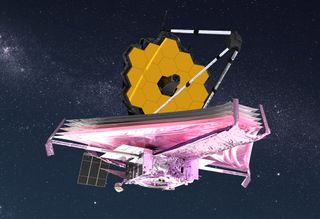Robert Lea is a science journalist in the U.K. whose articles have been published in Physics World, New Scientist, Astronomy Magazine, All About Space, Newsweek and ZME Science. He also writes about science communication for Elsevier and the European Journal of Physics. Rob holds a bachelor of science degree in physics and astronomy from the U.K.’s Open University. Follow him on Twitter @sciencef1rst.
Latest articles by Robert Lea

Newly discovered 'cosmic unicorn' is a spinning dead star that defies physics: 'We have a real mystery on our hands'
By Robert Lea published
Two teams of astronomers have simultaneously discovered a strange, spinning dead star that seems to defy our current understanding of both neutron stars and white dwarfs.

'The future for this baby planet doesn’t look great.' Exoplanet is shrinking before the X-ray eyes of NASA's Chandra space telescope
By Robert Lea published
Astronomers have used the Chandra X-ray telescope to observe an exoplanet as it disintegrates because its parent star is bombarding it with radiation.

A doomed exoplanet is caught in a 'death spiral' around its star. Can it survive?
By Robert Lea published
A massive doomed exoplanet on a death spiral toward its parent star has three possible catastrophic fates.

Bad news for alien life? Earth-size planets may be less common than we thought
By Robert Lea published
Up to 200 worlds investigated by NASA's exoplanet-hunting TESS satellite could be bigger than predicted, a finding that could impact our search for alien life.

NASA X-ray spacecraft reveals secrets of a powerful, spinning neutron star
By Robert Lea published
Observations of a pulsar, consisting of a dead star spinning 600 times a second, and feasting on a stellar companion reveal the source powering its emissions.

Astronomers discover a cosmic 'fossil' at the edge of our solar system. Is this bad news for 'Planet 9'?
By Robert Lea published
Astronomers using the Subaru Telescope have discovered a strange new body in a weird orbit at the edge of the solar system, which could be bad news for Planet Nine theories.

JWST finds unusual black hole in the center of the Infinity Galaxy: 'How can we make sense of this?'
By Robert Lea published
Everything about the Infinity Galaxy, recently discovered by the JWST, is strange. One odd feature could be the 1st evidence of a "direct collapse" black hole.

Astronomers witness the birth of a planetary system for the 1st time (video)
By Robert Lea published
Astronomers have witnessed the birth of an entirely new star system for the first time. The budding planets are forming around the infant star HOPS-315.

Our Milky Way galaxy may be surrounded by 100 undetected 'orphan' galaxies
By Robert Lea published
New research suggests that the Milky Way should be surrounded by as many as 100 undetected tiny and faint "orphan" galaxy companions.

The precursors of life could form in the lakes of Saturn's moon Titan
By Robert Lea published
New research indicates that cellular "pockets" that are the first step toward protocells, the precursors of life, could form in the methane seas of Saturn's moon Titan.

Ravenous 'vampire' stars may use cosmic accomplices to help devour stellar victims
By Robert Lea published
Astronomers have discovered that vampire white dwarfs that feast on victim companion stars have assistance in acquiring prey in the form of lurking third stars.

Astronomers discover monster exoplanet hiding in 'stellar fog' around young star
By Robert Lea published
A monster exoplanet as big as 10 times the size of Jupiter has emerged from the stellar gas and dust surrounding a young star, thanks to the telescope tag team of Gaia and ALMA.

Gravitational waves reveal most massive black hole merger ever detected — one 'forbidden' by current models
By Robert Lea published
Gravitational wave detectors have "heard" the ripples in space caused by the most massive black hole merger yet. One "forbidden" by current theoretical models.

Asteroid 2024 YR4 won't Earth but it could still ruin your day: Here's how
By Robert Lea published
Earth may be safe from an impact by the asteroid 2024 YR4, but it still has a chance of striking the moon. This lunar impact could pose a risk to space tech and astronauts.

Astronomers say new interstellar visitor 3I/ATLAS is 'very likely to be the oldest comet we have ever seen'
By Robert Lea published
3I/ATLAS isn't just fascinating because it is the third interstellar visitor found in the solar system; new research suggests it's also the oldest comet ever seen, at over 7 billion years old.

James Webb Space Telescope unwraps the dusty shrouds of dying stars
By Robert Lea published
Using the James Webb Space Telescope, astronomers have probed the dusty shells that surround dying stars called Wolf-Rayet stars.

Astronomers trace mysterious blast of X-rays to 'Die Hard' star that refuses to perish (video)
By Robert Lea published
Astronomers have traced a mysterious blast of X-rays to a star that, like a cosmic action hero, just refused to die.

JWST finds cosmic monster ruling tiny early galaxy: Was it forged by black holes from the Big Bang?
By Robert Lea published
The discovery of a monster-sized black hole in a pristine galaxy unspoiled by stellar death suggests growth via mergers between primordial black holes formed during the Big Bang.

The 'sound of the Big Bang' hints that Earth may sit in a cosmic void 2 billion light-years wide
By Robert Lea published
The "Hubble tension," one of the most frustrating and lingering problems in science, could be solved if Earth and the Milky Way sit in a low-density void.

Intelligent aliens could be drawn to Earth by 'leaking' airports
By Robert Lea last updated
Radar signals from "leaky" civilian and military aviation systems could act as a beacon to alien life, revealing intelligent life on Earth while helping us pinpoint them.

Captured dark matter may transform some 'failed stars' into 'dark dwarfs'
By Robert Lea last updated
Brown dwarfs, also known as "failed stars," could be corrupted by dark matter and transformed into "dark dwarfs" powered by the universe's strangest stuff.

How long would it take Superman to travel from Krypton to Earth?
By Robert Lea published
As James Gunn's Superman (2025) races into cinemas faster than a speeding bullet, we look at the planet that could have hosted his home world and why he might be older than he looks.
![A family portrait of galaxies from the CRISTAL survey. Red shows cold gas traced by ALMA’s [CII] observations. Blue and green represent starlight captured by the Hubble and James Webb Space Telescopes](https://cdn.mos.cms.futurecdn.net/eVukmgPN8vVBokz2SrUwMV-320-80.png)
'Time machine' reveals hidden structures in the universe's first galaxies (images)
By Robert Lea published
Using the ALMA telescope, astronomers have revealed the internal structure of the first galaxies in the universe, hinting at how our cosmos took shape.

NASA's James Webb Space Telescope mission — Live updates
By Robert Lea last updated
Read the latest news about NASA's James Webb Space Telescope.

Very massive stars vomit vast amounts of matter before collapsing into black holes
By Robert Lea published
Very massive stars are cosmic "rock stars" that live fast, die young and leave black holes in their place. During this transformation, they may vomit out more stellar material than we knew.
Breaking space news, the latest updates on rocket launches, skywatching events and more!

